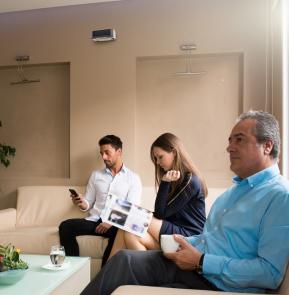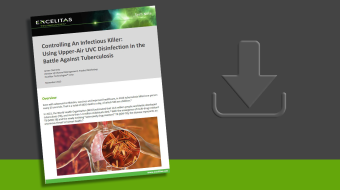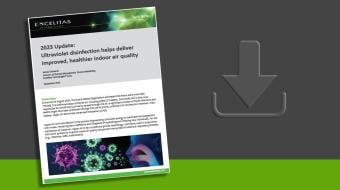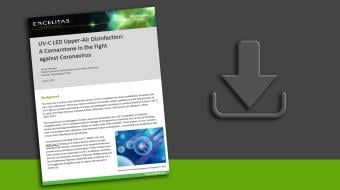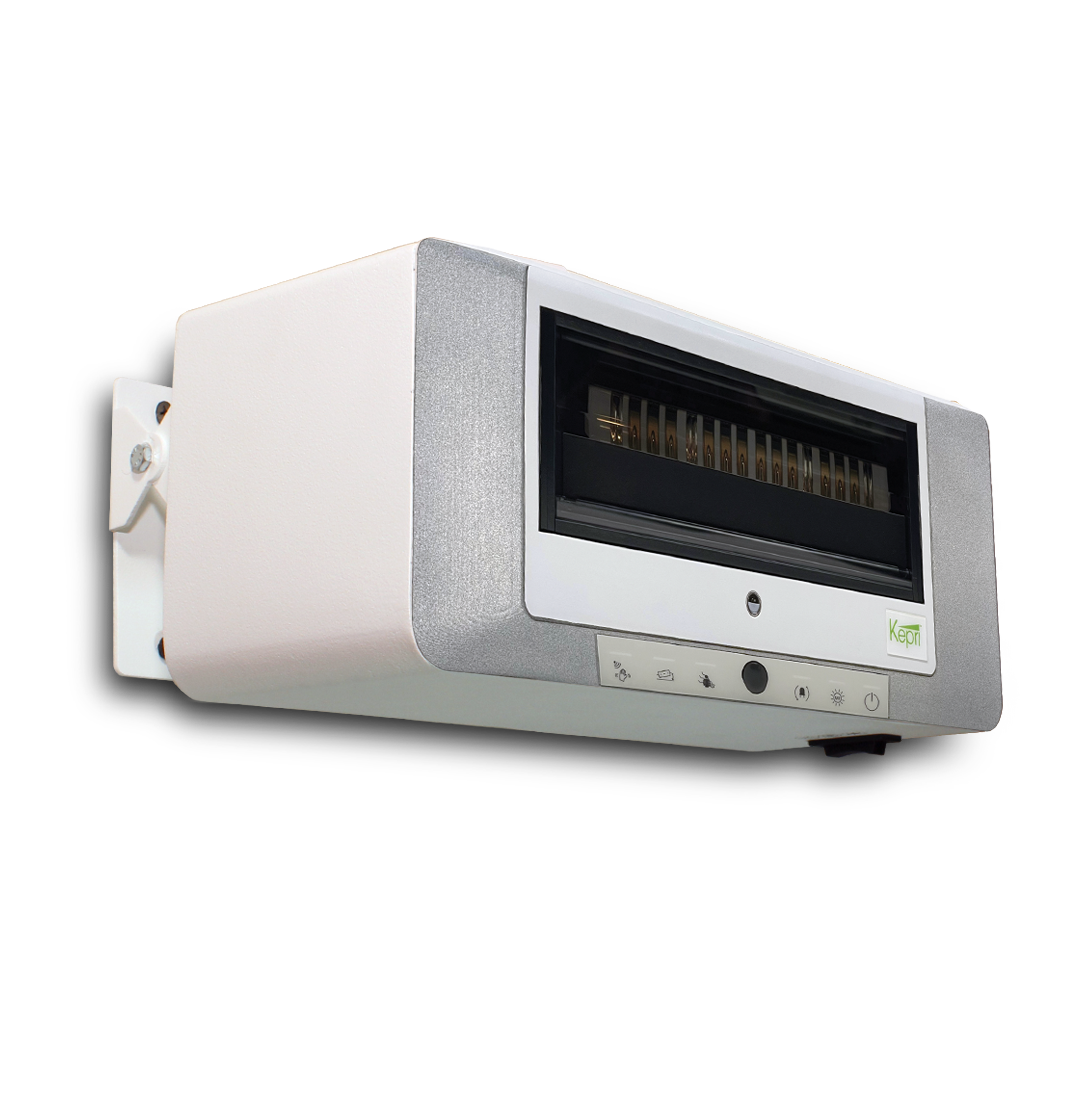
Kepri UVC Upper-Air Disinfection System
The Excelitas LED-based Kepri™ UVC Upper-Air Disinfection System provides safe, effective, real-time disinfection of upper-level room air regardless of room occupancy. Kepri’s potent UVC energy is effective against a wide range of pathogens including bacteria, mold and viruses such as those that cause COVID-19. With a truly unique design, our Kepri UVC Upper-Air Disinfection System allows for safe and effective room air disinfection without emitting any harmful or environmentally unfriendly ozone gas.
![Kepri Upper Air UVC Disinfection System]() Download our latest white paper on "UVC LED Upper-Air Disinfection: A Cornerstone in the Fight against Coronavirus".
Download our latest white paper on "UVC LED Upper-Air Disinfection: A Cornerstone in the Fight against Coronavirus".
The Upper-Air Concept
As pathogens pass through the active UVC disinfection zone, the UVC light damages the pathogens’ DNA/RNA, preventing its ability to replicate and effectively inactivating its ability to infect and spread. This continuous disinfection offers higher levels of effectiveness when compared to other traditional UV lamp-based air germicidal treatments at lower power.
The compact Kepri UVC Upper Air-Disinfection System is easy to install in a wide variety of spaces. Featuring low noise operation and a dust free optical chamber, this low-profile design minimizes maintenance requirements and ensures maximum UVC emission.
Occupant-Safe Operation
As safety is critical in UVC disinfection, Excelitas sets the industry standard with a three-tiered sensor monitoring system to ensure safe operation, even in fully occupied rooms:
- Tilt Sensor: a safety feature to ensure no harmful UVC energy is emitted into the lower part of the room.
- Presence Sensor: detects anyone in the UVC central emission field (i.e. changing a lightbulb on a ladder) and immediately turns off the UVC emission until the emission field is clear.
- Motion-Activated Occupancy Sensor and Switch: detects movement in the room and allows the user to select their individual operating preference using a three position selectable switch.
Excelitas meets a stringent UL-8802 standard which limits the amount of UVC energy into the lower part of the room, assuring safe operation.
Effective Pathogen Elimination
Third-party testing shows that Kepri reduces the airborne viral load by 99% in as little as 20 minutes. No matter if it is bacteria, mold, or virus, Kepri effectively reduces airborne pathogens. Click here to view our Efficacy Test Report.

Notes:
1.Equivalent air exchanges per hour (ACH) for a room with a 10ft (3.0m) ceiling.
2.Values are extrapolated from Intertek test data dated Dec 17, 2021- available on our website. Original single point test measured a 99.9% reduction of Coliphage φX174 (typical single stranded virus) in 20 minutes. Equivalent air exchanges for other pathogens will differ.
3.The times given assume perfect air mixing within the space (i.e. mixing factor = 1). Disinfection rates are dependent on air mixing. The following equivalent air exchange (ACH) data should only be used as a best-case guideline.
4.For more information please refer to the CDC guidelines for Environmental Infection Control in Health-Care Facilities (2003) Appendix B and the CDC Upper-Room Ultraviolet Germicidal Irradiation (UVGI) web page.
|
|
|
| Input voltage | 90/240 | VAC |
| Input frequency | 50/60 | Hz |
| Weight (bracket and device) | 5.5 (2.5) | lbs (kg) |
| Minimum mounting height* | 90.5 (2.3) | in (m) |
| Power consumption | 30 | W |
| Wavelength (typical) | 270 | nm |
*Measured from the bottom of the bracket
Warning: UVC ultraviolet rays are harmful to the eyes and skin. Avoid exposure to direct or reflected UVC rays.
- Motion-activated occupancy sensor & switch offers 3 operating modes for maximum flexibility and safety
- Integrated tilt sensor ensures safe upward UVC emission
- Presence sensor shuts off UVC if someone enters emission field as a safety feature, while offering longer UVC lifetime and flexibility
- Energy efficient with no mercury (Hg) or ozone emission for an environmentally-friendly and safe product
- Low noise operation and a dust free optical chamber to minimize maintenance required
- Adjustable mounting bracket, compact and light weight of 5 lbs (2.3kg) - Easy to install and small footprint for easy fit
- Replaceable LED light source for an extended product lifetime
- Meets UL-8802 Issue 4 Standard to ensure safety
Common UV Disinfection Light Sources
Light Source |
UV LED |
Pulse Xenon |
Mercury Vapor |
Excimer |
| Cost | $$$ | $$ | $ | $$$$ |
| Wavelength | ~265nm-280nm | 200nm-300nm | 254nm | 207nm-222nm with filter |
| Advantage |
• Small size
• Low voltage
• SMD packages easy to mount
|
• Free of Hg
• Broadband source
|
• Lower cost
• High efficiency
|
Potentially “safer” than other UV sources (w/filter) |
| Disadvantage | High cost per unit of energy | Supporting electronics are expensive |
• Contains Hg
• Less robust than other sources
|
• Limited suppliers
• Benefits unproven
• Limited sizes
|
Less common light sources include metal hailde and deuterium
Why use Kepri?
Kepri™ utilizes the Upper-Air disinfection concept. With Upper-Air disinfection, pathogens pass through the active UVC disinfection zone due to natural and HVAC induced room convection. As pathogens pass through the active UVC disinfection zone, the UVC light damages the pathogens’ DNA/RNA, preventing its ability to replicate and thus, effectively inactivating its ability to infect and spread. This continuous disinfection offers higher levels of efficiencies when compared to other traditional UV lamp-based air germicidal treatments while offering a lower power.
Can UVC be used to inactivate viruses like SARS-CoV-2?
Yes, UVC energy can inactivate viruses’ harmful pathogens such as SARS-CoV-2, the virus that causes Covid-19. Generally speaking, UV disinfection is widely used to inactivate harmful microorganisms in the healthcare industry, in food processing, and wherever people may congregate.
Is there any microbial disinfection test data available?
Yes, we have conducted tests on hospital-acquired pathogens; please see our efficacy report available on our website.
What is UV energy?
UV energy is found on the electromagnetic spectrum from 100 nm – 400 nm and is divided into fourparts:
- 100nm – 200nm UVV
- Light rays can only travel in a vacuum; if emitted in non-vacuum space in the presence of oxygen, ozone (O3) will be produced
- 200nm – 280nm UVC
- Light rays most harmful to DNA
- 280nm – 320nm UVB
- Typically used in curing and other applications
- 320nm – 400nm UVA
- Typically used in most LED curing applications
Do all UVC light sources contain mercury (Hg)?
No. Of the four common UVC light sources, only low-pressure and medium pressure mercury lamps contain mercury. If your design requires a mercury-free solution, LED, xenon, or excimer lighting technologies can be utilized. The Excelitas Kepri Upper Air Disinfection System is LED based and does not contain mercury.
Does UVC disinfection happen only at 253.7 nm?
UVC disinfection happens over the entire UVC range (200 nm - 280 nm). Differences in a pathogen's peak absorption and structure can result in different optimum disinfection wavelengths. Historically, most disinfection tests were conducted at 253.7 nm because it was the peak emission wavelength of the commonly available Hg-vapor lamps.
Do all UVC sources create ozone?
Ozone production starts below 240 nm and peaks at 185 nm. Therefore, if your light source emits above 240 nm, then there is no ozone produced. The Excelitas Kepri System emits light that does not generate ozone.
Does Kepri filter the air while disinfecting?
While the Kepri unit effectively disinfects upper room air via UVC light, it does not use any mechanical filtration. This also means there are no filters requiring replacement.
Are there any replaceable parts on the Kepri?
The LED array is replaceable and is designed to be field serviceable. Replacement LED arrays are available from Excelitas. Please contact us for more information.
What is the lifetime of the Kepri?
The lifetime will depend on the time of operation and the duty cycle used. If operated continuously, the Kepri has an estimated lifetime of 2 years (ON for 12 hours per day or 8000 hours).
What is the warmup time of the Kepri?
The Kepri uses LED technology, which does not require a warmup period prior to reaching full output. It is ready to use as soon as it is turned on.
Does the Kepri comply to any safety and EM regulations?
Yes, the Kepri contains a three-tiered sensor monitoring system along with complying with a variety of safety and EM regulations, including the stringent UL-8802 requirement. Please see below:
CAN/CSA C22.2 No. 250.0-18_4th Ed. UL 1598_4th ed.-2018
Safety standard for L
UL 8802_Issue 4_August-2021
IEC 61010-1:2010/A1:2016 Safety requirements for electrical equipment for measurement, control, and laboratory use
EN 61010-1:2010/A1:2018 Safety requirements for electrical equipment for measurement, control, and laboratory use
IEC 62471:2006 (First Edition) Photobiological Safety of Lamps and Lamp Systems
Can Excelitas conduct a Covid-19 disinfection test?
External partners conduct our entire microbiological tests. SARS-CoV-2, the virus that causes Covid-19, is pathogenic and can be inhaled; this requires a biohazard level 3 facility. Often surrogates (similar pathogens) are used to test the effectiveness of a device; these tests typically happen at biohazard 1 facilities. However, recent studies have shown the effectiveness of UVC in the mitigation of airborne and surface-bound pathogens, particularly SARS-CoV-2. Refer to: UV Inactivation of SARS-CoV-2 across the UVC Spectrum: KrCl* Excimer, Mercury-Vapor, and Light-Emitting-Diode (LED) Sources (nih.gov)
Recently, the US government issued several announcements reaffirming the use of Ultraviolet Germicidal Irradiation (UVGI) in public and private institutions and encouraging the need for increased cleanliness of indoor air. Below are links to specific challenges and updated guidelines for implementing clean air enhancement devices such as UVGI in conjunction with supplementary technologies. You will also find links below to related articles.
WHITE HOUSE
Fact Sheet: “Biden Administration Launches Effort to Improve Ventilation and Reduce the Spread of COVID-19 in Buildings,” 17 March 2022
https://www.whitehouse.gov/briefing-room/statements-releases/2022/03/17/fact-sheet-biden-administration-launches-effort-to-improve-ventilation-and-reduce-the-spread-of-covid-19-in-buildings/
Fact Sheet: “BACK TO SCHOOL 2022: Giving Every School the Tools to Prevent COVID-19 Spread and Stay Safely Open All Year Long”, 16 August 2022
https://www.whitehouse.gov/briefing-room/statements-releases/2022/08/16/fact-sheet-back-to-school-2022-giving-every-school-the-tools-to-prevent-covid-19-spread-and-stay-safely-open-all-year-long/
Policy Statement: “Let’s Clear the Air on COVID,” 23 March 2022
A statement made by Dr. Alondra Nelson, head of the White House Office of Science and Technology Policy and Deputy Assistant to the President
https://www.whitehouse.gov/ostp/news-updates/2022/03/23/lets-clear-the-air-on-covid/
EPA
Announcement: “Clean Air for Buildings Challenge,” March 2022
https://www.epa.gov/system/files/documents/2022-03/508-cleanairbuildings_factsheet_v5_508.pdf
CDC
Guidance: Upper-Room Ultraviolet Germicidal Irradiation (UVGI),” 9 April 2021
https://www.cdc.gov/coronavirus/2019-ncov/community/ventilation/uvgi.html
Guidance: “Ventilation in Buildings,” updated 2 June 2021
https://www.cdc.gov/coronavirus/2019-ncov/community/ventilation.html
RELATED ARTICLES:
Dr. Edward A, Nardell (Feb 1, 2022). "If We’re Going to Live With COVID-19, It’s Time to Clean Our Indoor Air Properly." TIME. This article discusses the best ways to clean indoor air properly to avoid spreading viruses and the effectiveness of upper room disinfection.
Visit the TIME website to read more: https://time.com/6143799/covid-19-indoor-air-cleaning/
Damian McNamara (Dec 16, 2022). “Rise of 'Alarming' Subvariants of COVID 'Worrisome' for Winter.” Medscape. This article emphasizes the increasing need to control respiratory-transmitted disease, including RSV and COVID-19.
Visit the Medscape website to read more: Rise of 'Alarming' Subvariants of COVID 'Worrisome' for Winter (medscape.com)
|
|
|
| Input voltage | 90/240 | VAC |
| Input frequency | 50/60 | Hz |
| Weight (bracket and device) | 5.5 (2.5) | lbs (kg) |
| Minimum mounting height* | 90.5 (2.3) | in (m) |
| Power consumption | 30 | W |
| Wavelength (typical) | 270 | nm |
*Measured from the bottom of the bracket
Warning: UVC ultraviolet rays are harmful to the eyes and skin. Avoid exposure to direct or reflected UVC rays.
- Motion-activated occupancy sensor & switch offers 3 operating modes for maximum flexibility and safety
- Integrated tilt sensor ensures safe upward UVC emission
- Presence sensor shuts off UVC if someone enters emission field as a safety feature, while offering longer UVC lifetime and flexibility
- Energy efficient with no mercury (Hg) or ozone emission for an environmentally-friendly and safe product
- Low noise operation and a dust free optical chamber to minimize maintenance required
- Adjustable mounting bracket, compact and light weight of 5 lbs (2.3kg) - Easy to install and small footprint for easy fit
- Replaceable LED light source for an extended product lifetime
- Meets UL-8802 Issue 4 Standard to ensure safety
Common UV Disinfection Light Sources
Light Source |
UV LED |
Pulse Xenon |
Mercury Vapor |
Excimer |
| Cost | $$$ | $$ | $ | $$$$ |
| Wavelength | ~265nm-280nm | 200nm-300nm | 254nm | 207nm-222nm with filter |
| Advantage |
• Small size
• Low voltage
• SMD packages easy to mount
|
• Free of Hg
• Broadband source
|
• Lower cost
• High efficiency
|
Potentially “safer” than other UV sources (w/filter) |
| Disadvantage | High cost per unit of energy | Supporting electronics are expensive |
• Contains Hg
• Less robust than other sources
|
• Limited suppliers
• Benefits unproven
• Limited sizes
|
Less common light sources include metal hailde and deuterium
Why use Kepri?
Kepri™ utilizes the Upper-Air disinfection concept. With Upper-Air disinfection, pathogens pass through the active UVC disinfection zone due to natural and HVAC induced room convection. As pathogens pass through the active UVC disinfection zone, the UVC light damages the pathogens’ DNA/RNA, preventing its ability to replicate and thus, effectively inactivating its ability to infect and spread. This continuous disinfection offers higher levels of efficiencies when compared to other traditional UV lamp-based air germicidal treatments while offering a lower power.
Can UVC be used to inactivate viruses like SARS-CoV-2?
Yes, UVC energy can inactivate viruses’ harmful pathogens such as SARS-CoV-2, the virus that causes Covid-19. Generally speaking, UV disinfection is widely used to inactivate harmful microorganisms in the healthcare industry, in food processing, and wherever people may congregate.
Is there any microbial disinfection test data available?
Yes, we have conducted tests on hospital-acquired pathogens; please see our efficacy report available on our website.
What is UV energy?
UV energy is found on the electromagnetic spectrum from 100 nm – 400 nm and is divided into fourparts:
- 100nm – 200nm UVV
- Light rays can only travel in a vacuum; if emitted in non-vacuum space in the presence of oxygen, ozone (O3) will be produced
- 200nm – 280nm UVC
- Light rays most harmful to DNA
- 280nm – 320nm UVB
- Typically used in curing and other applications
- 320nm – 400nm UVA
- Typically used in most LED curing applications
Do all UVC light sources contain mercury (Hg)?
No. Of the four common UVC light sources, only low-pressure and medium pressure mercury lamps contain mercury. If your design requires a mercury-free solution, LED, xenon, or excimer lighting technologies can be utilized. The Excelitas Kepri Upper Air Disinfection System is LED based and does not contain mercury.
Does UVC disinfection happen only at 253.7 nm?
UVC disinfection happens over the entire UVC range (200 nm - 280 nm). Differences in a pathogen's peak absorption and structure can result in different optimum disinfection wavelengths. Historically, most disinfection tests were conducted at 253.7 nm because it was the peak emission wavelength of the commonly available Hg-vapor lamps.
Do all UVC sources create ozone?
Ozone production starts below 240 nm and peaks at 185 nm. Therefore, if your light source emits above 240 nm, then there is no ozone produced. The Excelitas Kepri System emits light that does not generate ozone.
Does Kepri filter the air while disinfecting?
While the Kepri unit effectively disinfects upper room air via UVC light, it does not use any mechanical filtration. This also means there are no filters requiring replacement.
Are there any replaceable parts on the Kepri?
The LED array is replaceable and is designed to be field serviceable. Replacement LED arrays are available from Excelitas. Please contact us for more information.
What is the lifetime of the Kepri?
The lifetime will depend on the time of operation and the duty cycle used. If operated continuously, the Kepri has an estimated lifetime of 2 years (ON for 12 hours per day or 8000 hours).
What is the warmup time of the Kepri?
The Kepri uses LED technology, which does not require a warmup period prior to reaching full output. It is ready to use as soon as it is turned on.
Does the Kepri comply to any safety and EM regulations?
Yes, the Kepri contains a three-tiered sensor monitoring system along with complying with a variety of safety and EM regulations, including the stringent UL-8802 requirement. Please see below:
CAN/CSA C22.2 No. 250.0-18_4th Ed. UL 1598_4th ed.-2018
Safety standard for L
UL 8802_Issue 4_August-2021
IEC 61010-1:2010/A1:2016 Safety requirements for electrical equipment for measurement, control, and laboratory use
EN 61010-1:2010/A1:2018 Safety requirements for electrical equipment for measurement, control, and laboratory use
IEC 62471:2006 (First Edition) Photobiological Safety of Lamps and Lamp Systems
Can Excelitas conduct a Covid-19 disinfection test?
External partners conduct our entire microbiological tests. SARS-CoV-2, the virus that causes Covid-19, is pathogenic and can be inhaled; this requires a biohazard level 3 facility. Often surrogates (similar pathogens) are used to test the effectiveness of a device; these tests typically happen at biohazard 1 facilities. However, recent studies have shown the effectiveness of UVC in the mitigation of airborne and surface-bound pathogens, particularly SARS-CoV-2. Refer to: UV Inactivation of SARS-CoV-2 across the UVC Spectrum: KrCl* Excimer, Mercury-Vapor, and Light-Emitting-Diode (LED) Sources (nih.gov)
Recently, the US government issued several announcements reaffirming the use of Ultraviolet Germicidal Irradiation (UVGI) in public and private institutions and encouraging the need for increased cleanliness of indoor air. Below are links to specific challenges and updated guidelines for implementing clean air enhancement devices such as UVGI in conjunction with supplementary technologies. You will also find links below to related articles.
WHITE HOUSE
Fact Sheet: “Biden Administration Launches Effort to Improve Ventilation and Reduce the Spread of COVID-19 in Buildings,” 17 March 2022
https://www.whitehouse.gov/briefing-room/statements-releases/2022/03/17/fact-sheet-biden-administration-launches-effort-to-improve-ventilation-and-reduce-the-spread-of-covid-19-in-buildings/
Fact Sheet: “BACK TO SCHOOL 2022: Giving Every School the Tools to Prevent COVID-19 Spread and Stay Safely Open All Year Long”, 16 August 2022
https://www.whitehouse.gov/briefing-room/statements-releases/2022/08/16/fact-sheet-back-to-school-2022-giving-every-school-the-tools-to-prevent-covid-19-spread-and-stay-safely-open-all-year-long/
Policy Statement: “Let’s Clear the Air on COVID,” 23 March 2022
A statement made by Dr. Alondra Nelson, head of the White House Office of Science and Technology Policy and Deputy Assistant to the President
https://www.whitehouse.gov/ostp/news-updates/2022/03/23/lets-clear-the-air-on-covid/
EPA
Announcement: “Clean Air for Buildings Challenge,” March 2022
https://www.epa.gov/system/files/documents/2022-03/508-cleanairbuildings_factsheet_v5_508.pdf
CDC
Guidance: Upper-Room Ultraviolet Germicidal Irradiation (UVGI),” 9 April 2021
https://www.cdc.gov/coronavirus/2019-ncov/community/ventilation/uvgi.html
Guidance: “Ventilation in Buildings,” updated 2 June 2021
https://www.cdc.gov/coronavirus/2019-ncov/community/ventilation.html
RELATED ARTICLES:
Dr. Edward A, Nardell (Feb 1, 2022). "If We’re Going to Live With COVID-19, It’s Time to Clean Our Indoor Air Properly." TIME. This article discusses the best ways to clean indoor air properly to avoid spreading viruses and the effectiveness of upper room disinfection.
Visit the TIME website to read more: https://time.com/6143799/covid-19-indoor-air-cleaning/
Damian McNamara (Dec 16, 2022). “Rise of 'Alarming' Subvariants of COVID 'Worrisome' for Winter.” Medscape. This article emphasizes the increasing need to control respiratory-transmitted disease, including RSV and COVID-19.
Visit the Medscape website to read more: Rise of 'Alarming' Subvariants of COVID 'Worrisome' for Winter (medscape.com)
